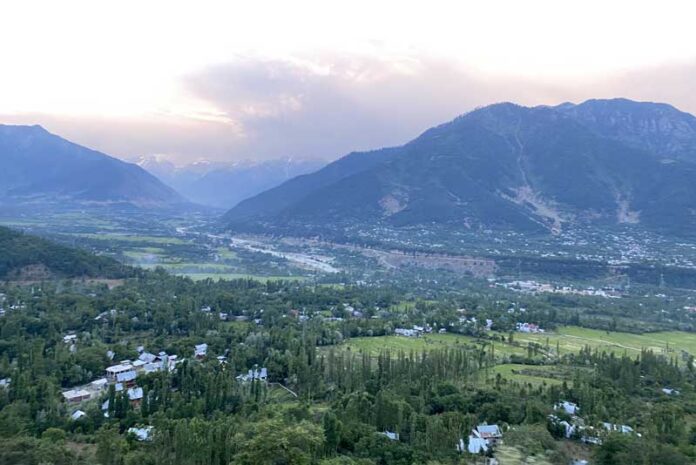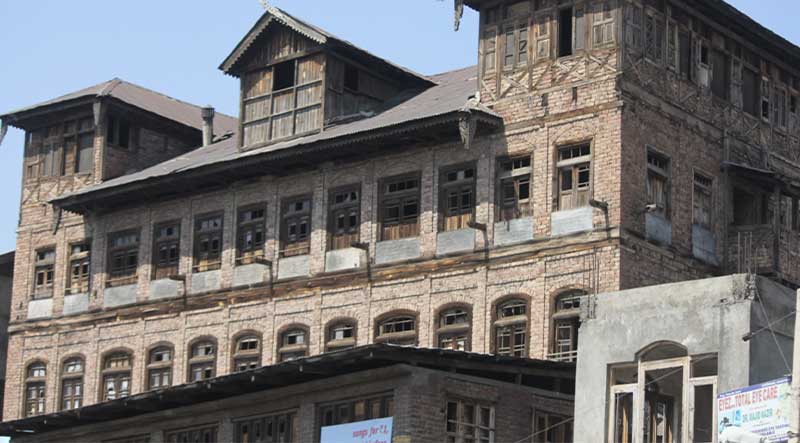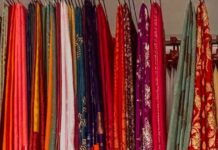By Malika Kaloo
In the quiet corners of Kashmir, where the echoes of a bygone era linger like whispers in the wind, there lies a tale of a land that once knew nothing but peace. Fatima, 85, carries the weight of memories inscribed on her weathered hands. Hands adorned with the intricate map of a life lived in the embrace of simplicity, where time flowed like the gentle Jhelum river that wound its way through the valley.
As Fatima speaks about the yesteryears, a time when the valley of Kashmir bore an uncomplicated existence, her eyes fill with tears.
“What is now a battlefield between the two countries, was once a land of tranquility.”
Her pheran, a traditional Kashmiri gown, flows down to her knees, and Kangri, a pot of glowing embers, warms her aged bones.
“It was an era when the air bore the scent of peace and the laughter of a close-knit community echoed through every alley and lane,” she says with a choked voice.
Fatima vividly remembers the time when 10-15 family members shared the warmth of a single household. Women, not confined by the walls of their homes, actively toiled in the fields, nurturing the very soil that bore the fruits of their labor. The literacy rates were humble, but the richness of community life compensated for the lack of formal education.
In the enchanting memories of Fatima’s childhood, the woody forest near her house was not just a collection of trees. It was a cathedral of wonders, a sanctuary where laughter echoed through the leaves, and the scent of adventure lingered in the air. As a young girl, she spent her afternoons amidst the tall woods, riding horses.
“I was a fierce horse rider. I wasn’t always this fragile,” she laughs.
As the sun dipped below the horizon, Fatima’s magical afternoons transformed into serene evenings. The warmth of Bukhari, a traditional Kashmiri fireplace, beckoned her home. In the cozy embrace of the flickering flames, she gathered with her family, listening to her grandmother’s stories.
“We had peace of mind, unlike today,” she says. “Sukoon (peace) has become rare these days.”
In the 1950s, a paradigm shift occurred with the arrival of European travelers in the Misbagh area of Ganderbal where Fatima lives. These settlers brought with them new technology and innovations, previously unknown to the people of Kashmir.
Fatima recalls how they crafted a marvel from stones and wood, a structure that encircled a natural spring and housed small almirahs.
“This ingenious construction served as a primitive refrigerator and people used to preserve mutton and vegetables there.”
Among these settlers were doctors who stitched healthcare into the fabric of everyday life and educationists who became a beacon of hope for underprivileged children.
Fatima’s son Mohammad Shafi, 65, weaves the threads of cross-cultural exchange into the conversation. His voice resonates with a sense of nostalgia.
Shafi recounts the story of Yousuf, a man from the Gujjar community settled on the hilly slopes of Kashmir. The foreigners adopted his aunts and uncles and sent them to Europe for an enhanced educational experience.
The Europeans departed from Kashmir in the 1970s. Some met their end in the same valley where they had woven tales of philanthropy and education.
Shafi, like a guardian of history, adds another layer to his narrative. He recalls the influx of approximately 100,000 Pashtun tribesmen in July 1954 from Peshawar in Pakistan. Strangers to nationality, they were granted Indian citizenship in a ceremony that resonated through the village of Gutlibagh in Ganderbal. Bakshi Ghulam Mohammad, the then prime minister of Jammu and Kashmir, presided over the event, bestowing citizenship certificates like tokens of belonging.
“These Pashtuns,” Fatima interjects, “still speak the Pashto language, and they’ve retained their cultural practices.”
“Even today, they convene ‘Jirgas’ (an assembly of community elders) to address community matters,” Shafi adds.
A member of this community, Haji Mir Alam emerged as a leader, serving as an MLC (Member of Legislative Council) in Bakshi’s administration.
Transitioning from his traditional roots, Sanaullah, another Pashtun living in Kashmir, became a newsreader at All India Radio. This embarked him on a journey that led him to the bustling city of Delhi.
The Pashtuns, beyond Gutlibagh, formed communities in various parts of Kashmir, including the picturesque Khiram Sirhama, where their cultural practices endured.
“The situation of Kashmir started turning serious in the 1980s and as you know 1990s marked the beginning of an era of violence that is ongoing,” Fatima says in a grim tone.
“During the militancy (1990s), we could not really go out without fearing for our lives.”
Militancy, also known as Kashmir insurgency, is an ongoing separatist militant insurgency in the region.
For more than thirty years, the valley, once a serene haven, has endured the relentless onslaught of ceaseless bloodshed and turmoil. What was once synonymous with tranquility has now become inextricably linked with violence and strife.
Sitting on her wooden couch, enveloped in the warmth of a Kashmiri handwoven fabric, Fatima reflects on her life. The nostalgia is not for herself alone but for the generations yet to come—her grandchildren and great-grandchildren who could not witness the Kashmir she once knew, a Kashmir adorned with peace and undisturbed tranquility.
“May Allah bring prosperity to our Kashmir so these children could see what we saw.”
Fatima speaks of a time when the essence of “Kashmiriyat” pulsed through the veins of the land.
“We were embedded in our culture and our values.”
Now, as she contemplates the present, a sigh escapes her lips. “We lost our culture to the outsiders.”
Fatima’s heart aches for nights when they could sleep with their doors unbolted because there was no fear. She longs for the days when the news they heard was devoid of any violence that now echoes through the valley almost daily.
She wishes for a tomorrow where her descendants can once again breathe in the pure, peaceful air of a Kashmir adorned not with the debris of strife but with the blossoms of enduring peace.



















